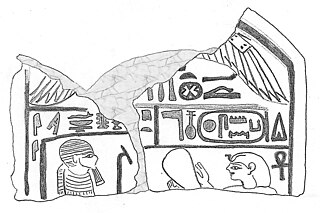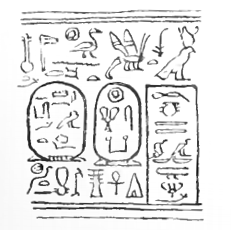
Userkare Khendjer was a minor king of the early Thirteenth Dynasty of Egypt during the Middle Kingdom. Khendjer possibly reigned for four to five years, archaeological attestations show that he was on the throne for at least three or four years three months and five days. Khendjer had a small pyramid built for himself in Saqqara and it is therefore likely that his capital was in Memphis.

The Fifteenth Dynasty was a foreign dynasty of ancient Egypt. It was founded by Salitis, a Hyksos from West Asia whose people had invaded the country and conquered Lower Egypt. The 15th, 16th, and 17th Dynasties of ancient Egypt are often combined under the group title, Second Intermediate Period. The 15th Dynasty dates approximately from 1650 to 1550 BC.

The Thirteenth Dynasty of ancient Egypt was a series of rulers from approximately 1803 BC until approximately 1649 BC, i.e. for 154 years. It is often classified as the final dynasty of the Middle Kingdom, but some historians instead group it in the Second Intermediate Period.

Hor Awibre was an Egyptian pharaoh of the early 13th Dynasty in the late Middle Kingdom.

Khaneferre Sobekhotep IV was one of the more powerful Egyptian kings of the 13th Dynasty, who reigned at least eight years. His brothers, Neferhotep I and Sihathor, were his predecessors on the throne, the latter having only ruled as coregent for a few months.

Sekhemkare Amenemhat V was an Egyptian pharaoh of the early 13th Dynasty during the Second Intermediate Period.
Renseneb Amenemhat was an Egyptian pharaoh of the 13th Dynasty during the Second Intermediate Period. According to egyptologist Kim Ryholt, Renseneb was the 14th king of the dynasty, while Detlef Franke sees him as the 13th ruler and Jürgen von Beckerath as the 16th. Renseneb is poorly attested and his throne name remains unknown.

Semenkare Nebnuni is a poorly attested pharaoh of the early 13th Dynasty during the Second Intermediate Period. He is mainly known for his position in the Turin King List.

Sekhemre Khutawy Amenemhat Sobekhotep was an Egyptian pharaoh of the early 13th Dynasty.

Seuserenre Khyan (also Khayan or Khian was a Hyksos king of the Fifteenth Dynasty of Egypt, ruling over Lower Egypt in the second half of the 17th century BCE. His royal name Seuserenre translates as "The one whom Re has caused to be strong." Khyan bears the titles of an Egyptian king, but also the title ruler of the foreign land. The later title is the typical designation of the Hyksos rulers.

Seankhibre Ameny Antef Amenemhat VI was an Egyptian pharaoh of the early Thirteenth Dynasty.
Sewadjkare was an Egyptian pharaoh of the 13th Dynasty during the early Second Intermediate Period.

Hotepibre Qemau Siharnedjheritef was an Egyptian pharaoh of the 13th Dynasty during the Second Intermediate Period.

Sekhemkare Amenemhat Senebef was an Egyptian pharaoh of the early 13th Dynasty, often considered as the final part of the late Middle Kingdom or early Second Intermediate Period.

The Abydos Dynasty is hypothesized to have been a short-lived local dynasty ruling over parts of Middle and Upper Egypt during the Second Intermediate Period in Ancient Egypt. The Abydos Dynasty would have been contemporaneous with the Fifteenth and Sixteenth Dynasties, from approximately 1650 to 1600 BC. It would have been based in or around Abydos and its royal necropolis might have been located at the foot of the Mountain of Anubis, a hill resembling a pyramid in the Abydene desert, close to a rock-cut tomb built for pharaoh Senusret III.

Sekhemraneferkhau Wepwawetemsaf was an Egyptian pharaoh during the Second Intermediate Period.

Menkhaure Snaaib was an Egyptian pharaoh during the Second Intermediate Period between the Middle Kingdom and New Kingdom at the end of the Middle Bronze Age.

Sekhemrekhutawy Khabaw was an Egyptian pharaoh of the early 13th Dynasty during the Second Intermediate Period.

Djedkheperew was an Egyptian pharaoh of the 13th Dynasty reigning for an estimated two-year period, from c. 1772 BC until 1770 BC. According to Egyptologists Kim Ryholt and Darrell Baker, Djedkheperew was the 17th king of this dynasty. Djedkheperew is this pharaoh's Horus name; the prenomen and nomen of Djedkheperew, which would normally be employed by modern conventions to name a pharaoh, are unknown.

Sebkay was an ancient Egyptian pharaoh during the Second Intermediate Period. For a long time his position created problems and he was most often placed into the 13th Dynasty. However, the discovery of the tomb of a king with the name Senebkay make it very likely that Sebkay is identical with the latter and the writing of the name Sebkay is just a misspelling of the name.


















